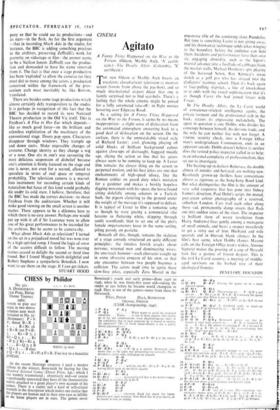CHESS by Philidor
No. 321.
A. DIJNAUJVAROS: (1st Prize, Hirlap Theme Tourney 1962) mitre to play and mate in two moves
solution next week
Solution to No. 32, (Bettmann): P - K 6!, threat B -K 5 t.. R x Kt ch 2 BxR (set P xR).
I...Kt-B 7; 2 Kt- Q 5. ... Kt -B 5; 2 Kt - Kt 4. I.. . B - Q 5; 2B P; 2 P x R. Fine key to a beautiful At the recent Hastings congress I paid a modest tribute to the winner, Botwinnik by buying his One Hundred Selected Games (Dover Press, 14s.) which I can warmly recommend • objectively and—of course —profoundly annotated they have all the characteristic merits attached to a great player's own account of his games. There is a reality and a kind of self-critical warmth in the description which makes one realise that the Players are human and in their own eyes as fallible as we lesser players are in ours. The games cover - Q 2. I . B else; 2 Q-B 5. . . R x problem.
so men;
WHITE (9 men) Botwinnik's youth and early prime—from 1926 to 1946, when he was thirty-five years old—taking the reader to just before he became world champion in 1948. Here is one of the games—notes from these by Botwinnik.
White, PANOV Black, BOTWINNIK Opening, FRENCH (USSR championship, 1940)
z - K 4 P - K 3
2 P - Q 3 . . . . . White wants to avoid the prepared variations .. . Panov . . . is one of those players who readily go in for any complications (even disadvantageous ones) in the confidence that in such positions he is bound to outplay his opponent!' [We all know them—Panov is not a purely Soviet phenomenon.)
B 4 3 It-KB3 Kt-Q/33
4 2 Kt - Q 2 - Q 4 5 - K 2 . . . P - K Kt 3 and B - Kt 2 is the correct plan.
B -3
- B 3 K Kt- K2 7 Kt-KBr• . 7 P- Q 4 is correct. Botwinnik com- ments that as the game was proceeding too normally, Panov decided to create some difficulties for himself.
0 - 0
8 Kt - K 3 P - B 4! 9 PxQP PxP
zo K Kt 3 . . . with the idea Kt - Kt 2, B - B 4, B x B, leaving Black weak on the black squares. 10 . P- B5
rz Kt - Kt - 10 3
Q- Kt 3 . . . successfully—if that is the word—tempt- ing Black to sacrifice the Q Kt P.
12 . . B- K_3!
,r3 Kt" xP XIC1
14 BxKt BxB
rs PxB RxP
16 Q is Kt P . .otherwise Black has much the better position and equal. material. Now Black has to play exactly, as he stands to lose an ending.
r6.. . Kt - R 4
t7 Q- R6 B - B Forcing the queen on to a more exposed square. - Kt 5 B- Kt 5 19 10 - Kt r Q - B 2! Threatening 20 . . . P-QR3 and also 20 . . R - Kt ;I; 21 Q - R 6, B - B I winning the queen in either case—but White is not yet dead. 20 P- Kt 4! Kt- Kt 2 ro . PxP??; 21 QxQPchand 22 Qpx R ch. 21 Px - Q 3! A delightful reply in kind-22 P 22 Q- K x Kt?, Q P ch followed by 23 ... Q x12 ch. 1 2 QxP 23 13 Y.B R x B 24 Kt-K2 R- Kr 25 0 - 0 - 0 P - Q R 4 Botwinnik points out that he should at once have played 25 . . . R - K 2! followed by 26 . . . R - Kt 2. He admits to rejecting It - K 2 because 01 26 Kt - Q 4, R - Kt 2; 27 Kt - Kt 3—overlooking that 26 Kt - Q 4?? was met by 26 ... R x Kt!
26 K-Ktr P-R5
27 Kt - Q 4 . . . 27 K - K t loses to 27 . . . P - R 6;
28 Q - St 2, R x Kt!; 29 Q i R, Q x. P ch; 3o K - Kt 1, R Kt 5 ch.
27 R-K 21
28 P- B3 R-R 5
29 K R - K r! . . . A splendid attempt to save the game which only just fails. 29 K - K 1, P - K 6!; 30 Q - Q 2, R x Kt;
31 P I R, Q x P ch; 32 K - Kt t, - Kt 2 ch loses at once for White.
R-Kt
30 R-K8ch! K-1512 3o ... Kt YR?, 31 QxR. 3ir R - B8 ch! K - K 21 3: K Pio; 32 Kt - K 6 ch! or K - Kt 3?; 32 R-Kt ch, K -R 4: 33 Q it!, Kt x 34 R - B 5 ch, K - R 3; 35 - 1.4 6 eh!, P R; 36 Kt - 5 ch, K - R 4; 37 Kt - Kt 7 ch with perpetual check! 32 R-Kzch R-K51 32 . . . 2?; 3315-137 ch! But the text move is a devastating and decisive reply.
33 B PxR RxQ ch 34 K xR Q- Kt 3 ch
35 K-13.2 K is H and all is over. The remaining 'un- necessary) moves were36 P x P, Kt - Kt 4; 37 -13 ch, K - K z ; 38 Kt- K 6, Kt - It 6 ch; 39 K - Q 1. Q - Kt 8 ch; iso - K 2, Q - Kt 7 ch ; 41 K - K 3, QxHP; 42 Resigns.


































 Previous page
Previous page